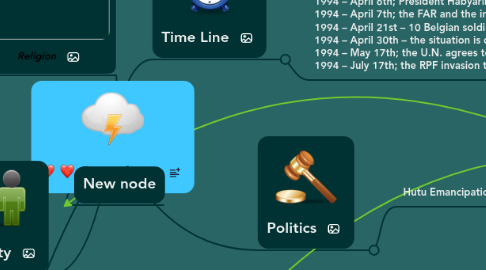Rwanda
by Svea Ashe

1. Religion
1.1. Roman Catholic Church
1.1.1. Church affirms that they knew about the genocides, but that they did not give permission.
1.1.2. Religious authorities failed to condemn the genocide
1.2. the religion in Rwanda is-56% is Roman catholic, 26% is Protestant.
1.2.1. New node
2. Ethnicity
2.1. "Tutsis intended to enslave Hutus"
2.2. Skin color
2.2.1. the war was mostly about ethnicity
2.2.2. lighter skinned tutsis were the minority; had to be slaves to the hutus. Tutsi women weere often subjected to sexual violence
2.2.3. Id cards explaining ethnicity
2.3. On April 6, 1994 the Hutus began the genocide that killed 800,000 people in 100 days.
3. Sexual Abuse used as war tactic
4. New node
5. Politics
5.1. Hutu Emancipation Movement
5.1.1. Civil War
5.1.1.1. emancipation kicked off more discrimination and Hutu's taste for power.
5.1.2. Media Propoganda began supporting the killings
5.1.2.1. Hutu ten commandments
5.1.2.2. local print and radio media
5.1.2.3. gender based propoganda
5.1.3. Numerous elite Hutu Polititions were getting involved in the genocide.
5.1.4. The genocide only ended when Tutsi rebels form other countries stopped the Hutus and halted the genocide.
6. Time Line
6.1. 1991 – March; a cease-fire is declared. Recognising they need motivated support, the FAR begins training and equipping civilian militia known as “interahamwe”, meaning “those who stand together”. 1991/2 – Local persecutions of Tutsis, including murders, are carried out. 1993 – August: following months of negotiations, Habyarimana and the RPF sign a peace and power sharing agreement – the Arusha Peace Accord. 2,500 U.N. troops are deployed to Rwanda to oversee its implementation, under the command of Canadian General Romeo Dallaire. 1993/4 – President Habyarimana delays implementation of power sharing; training of interahamwe increases. The extremist Hutu radio station, – Radio Mille Collines – starts broadcasting calls to attack Tutsis. 1994 – April; President Habyarimana restates his commitment to the Arusha Peace Accords. Extremist Hutus are alarmed by this development. 1994 – April 6th; President Habyarimana’s aeroplane is shot down. He and the President of neighbouring Burundi are killed. The blame is placed on the Tutsis. Massacres of Tutsis begin. 1994 – April 7th; the FAR and the interahamwe set up roadblocks. They round up thousands of Tutsis and moderate Hutu politicians, including women and children; most are massacred using ‘pangas’ – machete-like weapons. U.N. forces are forbidden to intervene, being only allowed to ‘monitor’ the situation. 1994 – April 21st – 10 Belgian soldiers are killed; the UN reduces its forces in the country from 2,500 to 250. 1994 – April 30th – the situation is debated in the United Nations Security Council. They refuse to declare it a ‘genocide’, which would mean they would be forced to intervene. 1994 – May 17th; the U.N. agrees to send 6,800 troops and policemen, mostly African, to Rwanda with powers to defend civilians, although this is delayed because of arguments over who will pay the bill and provide the equipment. A Security Council resolution says “acts of genocide may have been committed.” 1994 – July 17th; the RPF invasion troops reach the capital, Kigali. The massacres finally stop.

